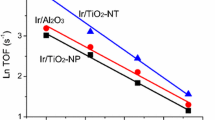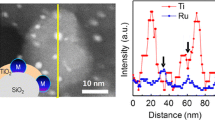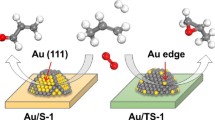Abstract
Interfacial perimeter sites between metal and support are often important for catalysis. A mononuclear titanium siloxy complex III, Ti(acac)2[OSiC6H5N(OCH3)2]2 was synthesized to generate TiOx units of different degrees of clustering to decorate Au nanoparticles. Two different methods of preparation were examined; one was to deposit III onto Au/SiO2 and the other was to form III-covered Au nanoparticle first before deposition onto SiO2. The former method generated more highly dispersed TiOx units, while larger domains of TiO2 were formed with the latter method, as deduced by UV–vis and XAS characterization. A model was proposed to explain how TiOx dispersity could be related to the preparative procedures. These samples were further tested as catalysts in selective oxidation of propane in a stream of O2 and H2. They exhibited different product selectivities. The sample with more dispersed TiOx units were more selective for acetone formation versus propene formation. The results confirmed the important role of both the Au–TiOx interface at the perimeter and the extent of Ti isolation in the TiOx phase in the reaction.






Similar content being viewed by others
References
Bond G, Thompson D (2000) Gold-catalysed oxidation of carbon monoxide. Gold Bull 33(2):41–50
Henao JD, Caputo T, Yang JH, Kung MC, Kung HH (2006) In situ transient FTIR and XANES studies of the evolution of surface species in CO oxidation on Au/TiO2. J Phys Chem B 110(17):8689–8700
Oxford SM, Henao JD, Yang JH, Kung MC, Kung HH (2008) Understanding the effect of halide poisoning in CO oxidation over Au/TiO2. Appl Catal A 339(2):180–186
Green IX, Tang W, Neurock M, Yates JT Jr (2011) Spectroscopic observation of dual catalytic sites during oxidation of CO on a Au/TiO2 catalyst, science. American Chemical Society (ACS), Washington, DC, pp 736–739
Saavedra J, Doan HA, Pursell CJ, Grabow LC, Chandler BD (2014) The critical role of water at the gold–titania interface in catalytic CO oxidation. Science 345:1599–1602
Carley AF, Morgan DJ, Song N, Roberts MW, Taylor SH, Bartley JK, Willock DJ, Howard KL, Hutchings GJ (2011) CO bond cleavage on supported nano-gold during low temperature oxidation. Phys Chem Chem Phys 13(7):2528–2538
Saavedra J, Whittaker T, Chen Z, Pursell CJ, Rioux RM, Chandler BD (2016) Controlling activity and selectivity using water in the Au-catalysed preferential oxidation of CO in H2. Nat Chem 8(6):584–589
Ostroverkh A, Johanek V, Kus P, Sediva R, Matolin V (2016) Efficient ceria–platinum inverse catalyst for partial oxidation of methanol. Langmuir 32(25):6297–6309
Kudernatsch W, Peng G, Zeuthen H, Bai Y, Merte LR, Lammich L, Besenbacher F, Mavrikakis M, Wendt S (2015) Direct visualization of catalytically active sites at the FeO–Pt(111) interface. ACS Nano 9(8):7804–7814
Senanayake SD, Stacchiola D, Rodriguez JA (2013) Unique properties of ceria nanoparticles supported on metals: novel inverse ceria/copper catalysts for CO oxidation and the water-gas shift reaction. Acc Chem Res 46(8):1702–1711
Corma A, Concepción P, Boronat M, Sabater MJ, Navas J, Yacaman MJ, Larios E, Posadas A, López-Quintela MA, Buceta D, Mendoza E, Guilera G, Mayoral A (2013) Exceptional oxidation activity with size-controlled supported gold clusters of low atomicity. Nat Chem 5(9):775–781
Turner M, Golovko VB, Vaughan OPH, Abdulkin P, Berenguer-Murcia A, Tikhov MS, Johnson BFG, Lambert RM (2008) Selective oxidation with dioxygen by gold nanoparticle catalysts derived from 55-atom clusters. Nature 454(7207):981–983
Wang Z, Beletskiy EV, Lee S, Hou X, Wu Y, Li T, Kung MC, Kung HH (2015) Amine-functionalized siloxane oligomer facilitated synthesis of subnanometer colloidal Au particles. J Mater Chem A 3(4):1743–1751
Mashayekhi NA, Wu YY, Kung MC, Kung HH (2012) Metal nanoparticle catalysts decorated with metal oxide clusters. Chem Commun (Camb) 48(81):10096–10098
Mashayekhi NA, Kung MC, Kung HH (2014) Selective oxidation of hydrocarbons on supported Au catalysts. Catal Today 238:74–79
Fujdala KL, Brutchey RL, Tilley TD (2005) Tailored oxide materials via thermolytic molecular precursor (TMP) methods. Topics in organometallic chemistry. Surf Interf Organometall Chem Catal 16:69–115
Fujdala KL, Tilley TD (2002) New vanadium tris(tert-butoxy)siloxy complexes and their thermolytic conversions to vanadia-silica materials. Chem Mater 14(3):1376–1384
Dombrowski JP, Johnson GR, Bell AT, Tilley TD (2016) Ga[OSi(OtBu)3]3·THF, a thermolytic molecular precursor for high surface area gallium-containing silica materials of controlled dispersion and stoichiometry. Dalton Trans 45(27):11025–11034
Jarupatrakorn J, Tilley TD (2002) Silica-supported, single-site titanium catalysts for olefin epoxidation. A molecular precursor strategy for control of catalyst structure. J Am Chem Soc 124(28):8380–8388
Ie Y, Hirose T, Nakamura H, Kiguchi M, Takagi N, Kawai M, Aso Y (2011) Nature of electron transport by pyridine-based tripodal anchors: potential for robust and conductive single-molecule junctions with gold electrodes. J Am Chem Soc 133(9):3014–3022
Missaghi MN, Galloway JM, Kung HH (2010) Bi(pyridyl) siloxane oligomeric ligands for palladium(II) acetate: synthesis and binding properties. Organometallics 29(17):3769–3779
Ravel B, Newville M (2005) ATHENA, ARTEMIS, HEPHAESTUS: data analysis for X-ray absorption spectroscopy using IFEFFIT. J Synchrotron Rad 12:537–541
Newville M Atoms.inp Archive: crystallographic data from GSECARS
Miller JT, Kropf AJ, Zha Y, Regalbuto JR, Delannoy L, Louis C, Bus E, van Bokhoven JA (2006) The effect of gold particle size on AuAu bond length and reactivity toward oxygen in supported catalysts. J Catal 240(2):222–234
Alvarez MM, Khoury JT, Schaaff TG, Shafigullin MN, Vezmar I, Whetten RL (1997) Optical absorption spectra of nanocrystal gold molecules. J Phys Chem B 101(19):3706–3712
Link S, El-Sayed MA (1999) Size and temperature dependence of the plasmon absorption of colloidal gold nanoparticles. J Phys Chem B 103(21):4212–4217
Claus P, Brueckner A, Mohr C, Hofmeister H (2000) Supported gold nanoparticles from quantum dot to mesoscopic size scale: effect of electronic and structural properties on catalytic hydrogenation of conjugated functional groups. J Am Chem Soc 122(46):11430–11439
Underwood S, Mulvaney P (1994) Effect of the solution refractive index on the color of gold colloids. Langmuir 10(10):3427–3430
Ghosh SK, Nath S, Kundu S, Esumi K, Pal T (2004) Solvent and ligand effects on the localized surface plasmon resonance (LSPR) of gold colloids. J Phys Chem B 108(37):13963–13971
Liu H, Yang W, Ma Y, Cao Y, Yao J, Zhang J, Hu T (2003) Synthesis and characterization of titania prepared by using a photoassisted sol–gel method. Langmuir 19(7):3001–3005
Blasco T, Camblor MA, Corma A, Perez-Pariente J (1993) The state of Ti in titanoaluminosilicates isomorphous with zeolite β. J Am Chem Soc 115(25):11806–11813
Weber RS (1995) Effect of local structure on the UV-visible absorption edges of molybdenum oxide clusters and supported molybdenum oxides. J Catal 151(2):470–474
de la Pena OS, Capel-Sanchez M, Blanco-Brieva G, Campos-Martin JM, Fierro JLG (2003) The usefulness of time-dependent density functional theory to describe the electronic spectra of Ti-containing catalysts. Angew Chem Int Ed 42(47):5851–5854
Klein S, Thorimbert S, Maier W (1996) Amorphous microporous titania–silica mixed oxides: preparation, characterization, and catalytic redox properties. J Catal 163(2):476–488
Blasco T, Corma A, Navarro M, Pariente JP (1995) Synthesis, characterization, and catalytic activity of Ti-MCM-41 structures. J Catal 156(1):65–74
Klaas J, Schulz-Ekloff G, Jaeger NI (1997) UV-visible diffuse reflectance spectroscopy of zeolite-hosted mononuclear titanium oxide species. J Phys Chem B 101(8):1305–1311
Jiang N, Su D, Spence JCH (2007) Determination of Ti coordination from pre-edge peaks in Ti K-edge XANES. Phys Rev B 76(21):214117/1–214117/9
Schwartz V, Mullins DR, Yan W, Zhu H, Dai S, Overbury SH (2007) Structural investigation of au catalysts on TiO2–SiO2 supports: nature of the local structure of Ti and Au atoms by EXAFS and XANES. J Phys Chem C 111(46):17322–17332
Farges F, Brown GE, Rehr JJ (1997) Ti K-edge XANES studies of Ti coordination and disorder in oxide compounds: comparison between theory and experiment. Phys Rev B 56(4):1809–1819
Wu ZY, Ouvrard G, Gressier P, Natoli CR (1997) Ti and O K edges for titanium oxides by multiple scattering calculations: comparison to XAS and EELS spectra. Phys Rev B 55(16):10382–10391
Notestein JM, Andrini LR, Kalchenko VI, Requejo FG, Katz A, Iglesia E (2007) Structural assessment and catalytic consequences of the oxygen coordination environment in grafted Ti–calixarenes. J Am Chem Soc 129(5):1122–1131
Eaton TR, Campos MP, Gray KA, Notestein JM (2014) Quantifying accessible sites and reactivity on titania–silica (photo)catalysts: refining TOF calculations. J Catal 309(0):156–165
Bravo-Suarez JJ, Bando KK, Fujitani T, Oyama ST (2008) Mechanistic study of propane selective oxidation with H2 and O2 on Au/TS-1. J Catal 257(1):32–42
Wu YY, Mashayekhi NA, Kung HH (2013) Au–metal oxide support interface as catalytic active sites. Catal Sci Technol 3(11):2881–2891
Acknowledgements
The authors acknowledge support of this work by the U.S. Department of Energy, Office of Science, Office of Basic Energy Sciences under Award Number DOE DE-FG02-03-ER15457. Linping Qian for experimental assistance, China Scholarship Council for support of Z.W. and X. H. This work made use of the EPIC, Keck-II, and/or SPID facility(ies) of Northwestern University’s NUANCE Center, which has received support from the Soft and Hybrid Nanotechnology Experimental (SHyNE) Resource (NSF ECCS-1542205), the MRSEC program (NSF DMR-1121262) at the Materials Research Center, the International Institute for Nanotechnology (IIN), the Keck Foundation, and the State of Illinois, through the IIN. XRD patterns were collected in the J.B. Cohen X-Ray Diffraction Facility supported by the MRSEC program of the National Science Foundation (DMR-1121262) at the Materials Research Center of Northwestern University. XAS were collected at Sector 5 of the DuPont-Northwestern-Dow Collaborative Access Team (DND-CAT) at the Advanced Photon Source (APS). DND-CAT was supported by Northwestern University, E.I. DuPont de Nemours & Co., and The Dow Chemical Company and the Advanced Photon Source is a U.S. Department of Energy (DOE) Office of Science User Facility operated for the DOE Office of Science by Argonne National Laboratory under Contract No. DE-AC02-06CH11357. The CleanCat Core facility was funded in part by the U.S. Department of Energy (DE-FG02-03ER15457). We also thank the Cabot Corporation for the gift of Cab-O-Sil L-90.
Author information
Authors and Affiliations
Corresponding authors
Additional information
X. Hou and Y. Wu have contributed equally in this work.
Zhen Wang—Experimental work were conducted at Northwestern University.
Electronic supplementary material
Below is the link to the electronic supplementary material.
Rights and permissions
About this article
Cite this article
Wang, Z., Hou, X., Wu, Y.Y. et al. Controlled Generation of TiOx–Au Interface Using Titanium Molecular Complex Bearing Pyridyl Anchors: Synthesis, Characterization and Catalysis. Top Catal 61, 800–809 (2018). https://doi.org/10.1007/s11244-018-0941-2
Published:
Issue Date:
DOI: https://doi.org/10.1007/s11244-018-0941-2




